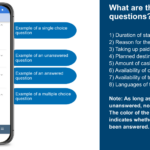The project “Claim Asylum EU” aims to help people seeking protection in the European Union. This is necessary because the border authorities at the EU’s external borders are breaking international law on a massive scale.
In the 1951 Geneva Convention relating to the Status of Refugees, signatory states agreed to enshrine the fundamental right to asylum in their national laws. Accordingly, any person fleeing persecution or serious harm from their country of origin can apply for international protection. The EU member states have also signed the Geneva Refugee Convention. They are also bound by the European Convention on Human Rights, which prohibits refoulement to states where persecution is imminent.
Nevertheless, people are being illegally deported back from countries like Greece, Croatia or Poland. A new app by the campaign #LeaveNoOneBehind could expose this practice and support those affected in the asylum process. I spoke to the project coordinator Mareike Ippen, who also works for the non-governmental organisation Sea-Watch, about this.
Dear Mareike, you are developing a web app with which people can submit their asylum application from a mobile device via a new website in the EU. Why is this project “Claim Asylum EU” necessary at all?
According to EU law, refugees are allowed to apply for asylum when they first arrive in Europe. Only if this is not successful can they be deported. However, the frightening reality is that time and again, refugees are illegally and brutally expelled from European border areas, for example from Poland to Belarus or from Greece to Turkey, without first being able to apply for asylum – the so-called pushbacks. With the help of our web app, people can exercise their right to asylum while still on the move, directly after entering European soil, before they might become deported.
That means your app is actually supposed to detect criminal behaviour?
It is supposed to help people exercise their right to asylum. But it should also draw attention to the problems and human rights violations on the European side. The application also builds up a kind of archive of pushbacks.
Can you briefly explain this technically? How is GPS data logged, and what other possibilities are there to document one’s own location with a mobile phone?
The GPS data is recorded via the browser on the mobile phones of the fugitives. However, since a GPS position is relatively easy to falsify, we have included the additional option of uploading a picture with a clearly identifiable reference point. The picture can be used afterwards as proof that the person has really set foot on Greek soil, for example.

Screenshot of the planned input screen (Claim Asylum EU).
How legally certain is this? Do you already have an assessment of this?
We are working with lawyers who are active in Greece and provide legal support to refugees and have also helped shape our project from a legal point of view. The submission of the asylum application via our web app meets legal requirements. Whether these are adhered to in practice is another matter. So it also depends on what one understands by “legal certainty”. In any case, the app and the sent messages also serve to document and prove that people were already in Europe and that the authorities knew about it, possibly then also for later legal proceedings.
In addition to Greece, I also see a need for your web app at the land border in Croatia or Malta, where refugees are being taken back to Libya from the sea rescue zone in violation of international law. Are you in contact with organisations or solidarity groups there? The aforementioned governments should feel challenged by you….
Regarding the return to Libya – the so-called pullbacks – a case is currently pending before the European Court of Human Rights. The lawyers are in contact with the complainants and are monitoring the proceedings.
Legally, European law also applies at the border and in transit zones. Therefore, Malta and Croatia would be a theoretical case for our application. The difference between Greece and Malta or Italy, however, is the size and location of the so-called search and rescue zones (SAR). These are internationally defined borders in the sea, where states with a sea border are responsible for sea rescue cases and have to bring people rescued from distress at sea to a safe harbour. The Italian and Maltese SARs start in the middle of the high seas in the Mediterranean.
However, there is usually no reception for mobile phones there and the bandwidth of satellite phones is extremely limited…
Yes, that is why people there cannot apply for asylum online. That’s why we first built our application as a prototype for the Greece-Turkey case, since internet is also available at sea here. Another possible use case is the Polish-Belarusian border, where unlawful pushbacks occur regularly.
Apart from the fact that people should not be deported, your app could make it easier to apply for asylum in general. Could this procedure catch on, like Ask the EU or the German one Frag den Staat have developed for freedom of information requests?
In principle, yes. In contrast to the mentioned platforms, however, “Claim Asylum EU” does not aim to simplify a complicated procedure, but to document the filing of the application – an asylum application can be made informally, it is enough to say “I would like to apply for asylum”.
The app could therefore be compared with the Alarmphone network, which documents distress calls and with which we will also cooperate. The people concerned usually manage to make the application themselves, the problem is rather that they are not given the opportunity to do so in the first place. It is therefore a question of preventing the authorities from claiming that someone has not made an application.
The EU Asylum Directive stipulates how such applications are to be made. What does it say, where do those affected actually have to present themselves?
The Asylum Procedures Directive dates back to 2013. Regarding the asylum application, Europe has the right to say that states must treat such requests as asylum applications if it can be assumed that the person concerned wishes to seek protection. Once an asylum application has been made, a formal procedure must be carried out, during which people may not be deported. Any state agency is responsible for receiving an asylum application. The formal asylum procedure must then be carried out by a competent authority, usually the asylum authority, in Germany for example the Federal Office for Migration and Refugees.
In addition to the EU Directive, human rights, in particular the European Convention on Human Rights, also prohibit deportation without a legal procedure. If states become aware of a person seeking protection through their staff, the ECHR applies and these states must examine whether there is a risk of a human rights violation in the case of deportation. There is no competent authority for the application of the Convention; all state actors are directly bound by it.
The addresses of the competent authorities in each country for the asylum application must not only be entered into the app, but also kept up to date. Aren’t you taking a big risk by promising something that might not be kept in a few years?
Basically, we can’t promise anything with the app, that’s important for us to emphasise once again. We use the legal provisions to make pushback and rejection as unlikely as possible and try to exhaust all possibilities. The fact that some states with an EU external border often do not care about the law has been impressively demonstrated by them in various places.
Of course, the database of the competent authorities requires maintenance. But the mails are sent not only to one, but to many authorities, and state actors are basically obliged to receive them and to take action. We know that a web app raises hopes. We want to fulfil this responsibility through monitoring and an obligation to keep the addresses up to date.
With all the considerations and finally the decision to start the project, where do you see risks?
It is clear to us that such a project involves numerous risks. However, the advantages outweigh the risks, both for those affected and in terms of documentation possibilities. For affected people, the main risk is that states will ignore the applications and they will still be rejected. Nevertheless, they have brought proof of having been on European territory, which they can use in later proceedings.
Another problem might be that the right to asylum could be enforced with the web app, but the right of self-determination of the persons concerned about the place of the request could not. This is because if an asylum application is made in Greece, onward travel to another country is no longer possible under the EU Dublin system. How have you considered this?
We are aware of this problem. However, with the app we are only trying to prevent pushbacks. We cannot change the fundamental weaknesses of the common European asylum system – as mentioned here, the attempted prevention of onward travel.
The app is also a technical challenge…
The past has shown that organisations that support people on the run run the risk of coming into the focus of repressive states that see human rights defenders as a threat and pushbacks as “fake news” spread by other states. We also come into this focus, which is why it is important for us to work as accurately as possible.
For example, it must not happen under any circumstances that those affected are not yet on European soil or in waters, and the app nevertheless “triggers”. This would be a perfect opportunity for states to discredit non-governmental organisations. So we want to counteract possible risks by doing a technically clean job that cannot be doubted.
When do you expect the app and the website https://claim-asylum.eu to go live?
The website will go online at the beginning of November.
Thank you very much for the interview!
Image: Refugees in life raft 17 September 2022, possibly pushed back by Greek Coast Guard (Turkish Coast Guard).





Leave a Reply